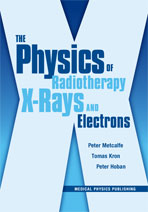
The Physics of Radiotherapy X-Rays and Electrons
Author: Peter Metcalfe, Tomas Kron and Peter HobanISBN: 9781930524361
Published: 2007 | 916 pp | Softcover
Price: $ 125.00
Health Physics | August 2008, Vol. 95, Number 2
This book consists of 14 chapters featuring all the up-to-date technology in the field of medical physics: medical linear accelerators, interaction properties of x-rays and electrons, dosimetry of megavoltage x-rays and electrons, x-ray beam properties, linear accelerator electron beam properties, radiotherapy treatment planning, special procedures such as stereotactic radiotherapy and intensity modulated radiotherapy (IMRT), calibration of megavoltage photon and electron beams, beam models parts I and II, quality assurance radiotherapy, patient immobilization and image guidance, radiation protection and room shielding, and tumor and normal tissue response.
Chapter one outlines how electrons and x-rays are produced by the linear accelerators. Chapter two describes the interactions of radiation therapy using x-ray and electron beams. Chapter three includes the various types of ionization chambers and dosimeters. Chapter four discusses the concepts of percent depth dose, and dose profiles of x-ray beams ranging from kilovoltage (kV) to megavoltage (MV) energies. Chapter five deals with the physical properties and aspects of electron beams in clinical practice. Chapter six describes the step-by-step approach in designing a treatment plan involving simulators, computed tomography (CT) scanner, nuclear magnetic resonance (NMR), position emission tomography (PET) and the computer planning system. Chapter seven covers complex procedures such as stereotactic radiosurgery (SRS), IMRT, image-guided radiotherapy (IGRT), and tomotherapy. Chapter eight includes the beam calibration protocols. Chapter nine reviews photon beam models that are currently used in monitor unit (MU) checking software and the inhomogeneity correction methods. Chapter ten describes photon beam methods based on convolution/superposition models and Monte Carlo methods. Chapter eleven provides a practical guide to quality assurance (QA) tests for linacs, electronic portal imaging devices (EPIDs), linac-mounted imaging devices, CT simulators, and radiotherapy treatment planning (RTP) computers. Chapter twelve describes dose delivery methods such as IMRT, SRS, and tomotherapy. Chapter thirteen outlines the radiation protection principles and practices that relate to the treatment room design and radiation safety tests. Chapter fourteen summarizes the radiation biology models.
At the end of each chapter is a series of questions with answers provided in the back of the book. Some of the questions are from The Q Book and some new questions have been included. These questions can be useful in preparing for the American Board of Radiology (ABR) examinations. However, there are only five questions for each chapter. An index is also available to help readers in navigating the various topics. This book is useful not only to practicing physicists in therapeutic radiation oncology but also to junior level physicists and the students who attempt to pursue medical physics as professions.
The book is well-written by a diverse group of noteworthy physicists: Peter Metcalfe, PhD, who is a physicist at Cancer Institute, Radiation Oncology Physics, Australia; Tomas Kron, PhD, who is a principal research physicist at Peter MacCallum Cancer Institute, Australia; and Peter Hoban, PhD, who is a senior product manager at Tomotherapy, Inc., Wisconsin. Each chapter starts with a basic concept or empirical equations or theory followed by the evidence-based approach as shown by the number of figures, photographs, and schematic diagrams. Black and white photographs are very dark and hard to see, especially the screen shots of isodose lines, depth dose, Monte Carlo (MC) calculated dose distributions, and three dimensional (3D) treatment plans generating. It is pointless in showing the black and white isodose lines since it is very difficult to eyeball different isodose lines in terms of percentage, i.e., 70%, 80%, 95%, 98%, 100%, and 120%. Not all chapters show only black and white, chapter 7 deals with Cyber Knife image guidance. It has color photographs of the equipments and snapshots of the MC dose distributions and isodose lines created by using ADAC Pinnacle planning system with 3D pencil beam algorithm.
Chapter fourteen is seemingly out of place, since it summarizes the radiation biology in regard to the use of radiation in tumor control, tumor dose homogeneity, and dose fractionation. Although it is an important concept, I feel that it should be written under a different subject, or perhaps be included in a different book, since it does not generally fall under the physics of radiation therapy using x-rays and electrons. The tone of the written language is easy to read and follow without losing details. Overall, the book is well received for its scientific merit and simplifications of the complex physics.
In conclusion, I do agree with the authors that this book has addressed some of the complex concepts that have not been covered in the first edition of the text, such as advances in shaping dose distribution around the target volumes using IMRT and in visualizing the target volumes with respect to the anatomy using IGRT techniques.
Hoang Tien Vu
Dept. of Medical Radiation Physics
College of Health Profession
Rosalind Franklin University of Medicine and Sciences
North Chicago, IL


